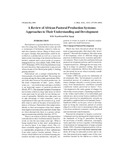A Review of African Pastoral Production Systems: Approaches to Their Understanding and Development
Abstract
Pastoralism is a system that has been in existence
for a long time. Scholars have come up with
a cornucopia of definitions related to what entails
this centuries old art. Many of these scholars
agree, though, that pastoralism could be described
as a production as well as a socio-cultural
system consisting of an interaction between
herders, animals and a given mode of resource
management (see, for example, Salih, 1990; Swift,
1977; Widstrand, 1975). From this definition it may
be said, therefore, that a pastoralist is any person
whose means of livelihood principally is tending
grazing animals.1
Pastoralism sets a unique relationship between
people, livestock and land. The strong ties
existing among the three make pastoralism different
from other forms of livestock production. As
the main components of land – grass, shrubs,
water, etc. – vary both in time and space, mobility
is an important aspect of pastoral production
(Swift, 1977). The seasonal variation of resources
necessitates relatively large land areas in which
some parts may be set aside for use during seasons
of optimality. Mobility does take place too
to take advantage of other situations, such as
exploitation of some specific resources (e.g., available
water or salts) or because of increased incidences
of disease. Pastoralists thus adapt nomadically
to their environment when their adaptation
requires movement beyond their home base
or when alternatively there is a greater advantage
in maximising mobility (Spooner, 1973).
There is no reason to believe that pastoralists
currently derive their livelihood entirely from livestock,
as was the case many years ago. What is
being implied here is that ‘pure’ pastoralism as
we used to know it no longer exists. The evidence
available suggests that pastoralists derive
a considerable proportion of their subsistence
from other sources besides animals. These activities
which hitherto never featured among pastoralists
include crop production, odd jobs, migration
to towns in search of salaried employment,
and even small businesses.
URI
http://hdl.handle.net/123456789/254https://www.researchgate.net/publication/265158336_A_Review_of_African_Pastoral_Production_Systems_Approaches_to_Their_Understanding_and_Development
http://repository.seku.ac.ke/handle/123456789/648
http://erepository.uonbi.ac.ke/handle/11295/28112
Collections
- Journal Articles (PAS) [303]

